Tour of Moons
We are not completely satisfied to look at moons in our Solar System through telescopes. Let’s take a spaceship ride to some of the planets in our Solar System to get close-up views of their moons. While this is an imaginary spaceship ride, we will view real images transmitted to Earth by Viking and Voyager spacecraft. Please fasten your (imaginary) seatbelts while we prepare to lift-off.
Start rocket launch sound effect at countdown. DIGITAL EFFECT: Begin Ignition At ignition, start blue daylight and orange covelights alternating in intensity. Turn on stars. Start diurnal motion and gradually accelerate while rocket noise gets louder. As rocket noise subsides, gradually bring diurnal motion to zero and dim daylight. Turn covelights off DIGITAL EFFECT: Begin Tour Start the solar system tour. Lift off Earth and view it from space. Do a slow orbit around Earth
Before we leave the neighborhood of Earth,
let’s get a super view of our own Moon.
DIGITAL EFFECT: Orbit On Show the orbit line of the Moon. DIGITAL EFFECT: Polar View Move Earth to the zenith and put the Moon’s orbit line roughly parallel to the dome horizon. DIGITAL EFFECT: Luna Scale up the size of the Moon to make it more visible.
VISUAL 18 (still): Moon Close-up
[Point out mountains, craters, maria.]
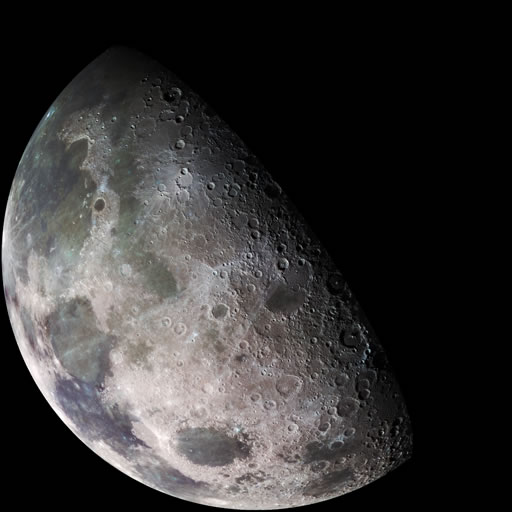
VISUAL 19 (still): Crater (Clementine image of Tycho)
An associated image with the Moon—a Clementine image of Tycho crater.
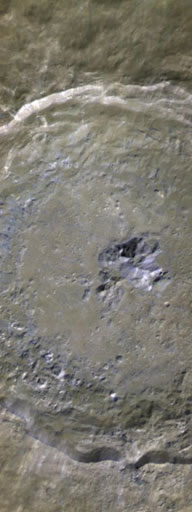
DIGITAL EFFECT: Full Moon
Turn off the Tycho image and scale the Moon back down to default size. Discuss what craters are and how they are formed. See references for latest info on Clementine, Lunar Prospector, and later missions.
There is evidence of water ice in polar regions of the Moon!
Where do we go now? Well, if it’s moons we want to see, there is no point in traveling to the two planets Mercury and Venus that are closer to the Sun than Earth. They have no moons at all. Let’s journey outward in the Solar System towards Mars.
[Play music for journey to Mars.]
DIGITAL EFFECT: Teleport Mars Turn diurnal motion on. Prepare us for “teleporting” to Mars by turning the sky so that Mars is positioned at the sweetspot, and highlighted with a colored arrow. DIGITAL EFFECT: Teleport! Teleport to Mars through a fade out/in. Upon arrival, stop diurnal and begin a slow orbital motion. Lower music.
VISUAL 20 (still): Mars and Phobos
Note the shapes of the illuminated parts of Mars and its moon Phobos.
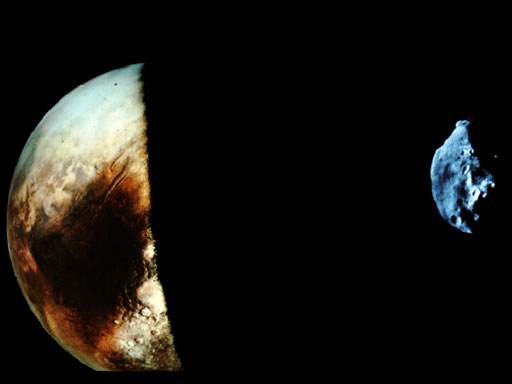
Can you explain those shapes?
[Quarter phase.]
From which direction is the sun shining?
[Have an audience member indicate with battery light pointer.]
DIGITAL EFFECT: Orbit On Turn on the moon orbits for Mars. DIGITAL EFFECT: Polar View Move Mars to the zenith, such that the moon orbits are roughly parallel to the dome horizon. Note: All the digital effects in this section should be programmed in a similar manner—1) move the planet to the sweetspot, 2) “teleport,” 3) show moon orbits, and 4) move the planet to polar view. Some or all of these planets and moons can be shown, as time allows. For the remainder of the tour, the presenter may choose to visit planets and their moons in any order they wish.
Phobos is only about 15 miles (10 km) long. It is very small compared to Earth’s Moon which is 2000 miles (3200 km) across. If you want to play baseball, but can’t find anyone to play, you could still have a good game on Phobos. The gravity on Phobos is so weak that if you stood on its surface, you could throw a baseball into orbit or beyond (just like Superman on Earth). So, you could pitch the ball in one direction, then pick up your bat and wait for the ball to come at you from the other direction.
DIGITAL EFFECT: Phobos Zoom in on Phobos for better viewing. Note: Zooming effects are to make a given moon more visible. Some moons have an associated still image or two, so show that image (if available), and then turn the image off and zoom out from the moon.
VISUAL 21 (still): Phobos (Zoom close-up view)
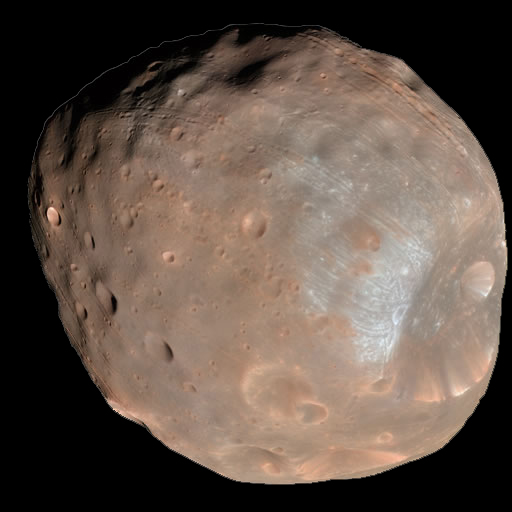
Mars may have a small moon compared to Earth’s Moon, but it has an extra moon just for good measure. This moon Deimos is only a bit smaller than Phobos.
DIGITAL EFFECT: Deimos
Zoom in on Deimos for better viewing.
VISUAL 22 (still): Deimos
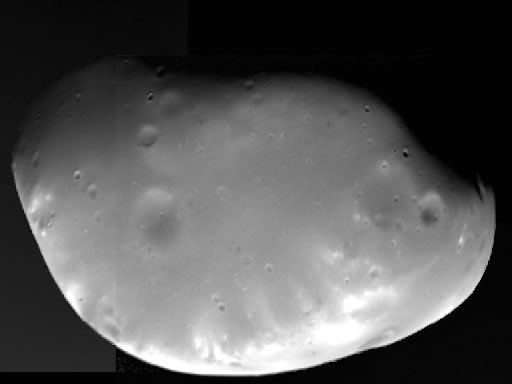
Let’s head on to the next planet out in the Solar System.
Anyone know which planet that is?
[Jupiter.]
[Music up for cruise to Jupiter.]
Let’s see those four moons we tracked before. They each have unique markings and geology.
DIGITAL EFFECT: Teleport Jupiter
Run through the “teleport” sequence—preparation, teleport, orbit lines, polar view (with stops)—for Jupiter, as we did with Mars (above).
VISUAL 23 (still): Jupiter and Moons
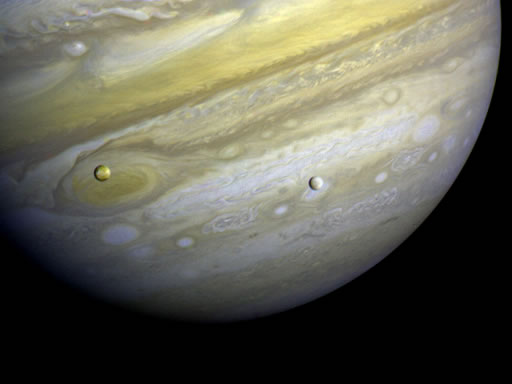
Optional VISUAL 24 (still): Jupiter’s Main Ring Toggle a still image of Jupiter’s Main Ring, taken by the Galileo spacecraft.

The Galileo spacecraft arrived at Jupiter on December 7, 1995. Galileo’s atmospheric probe plunged into Jupiter’s atmosphere and relayed information on the structure and composition of the Solar System’s largest planet, while the Galileo orbiter studied Jupiter and its moons, encountering one moon during each orbit.
DIGITAL EFFECT: Callisto
Zoom in on Callisto for better viewing.
VISUAL 25 (still): Global Callisto in Color (NASA Galileo mission)
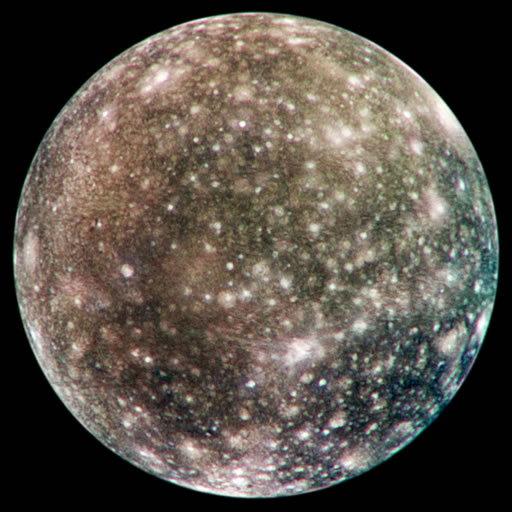
Callisto (the “white moon” we tracked) is pockmarked with ancient craters, easily visible as bright scars on the darker surfaces. In fact, Callisto is the most heavily cratered object in the Solar System. The crust of this moon shows remnant rings of enormous impact craters. The largest craters have apparently been erased by the flow of the icy crust over geologic time. The brighter craters seen here are thought to be mainly ice.
VISUAL 26: Callisto Scarp Mosaic (NASA Galileo mission)
[Show a still image of a Callisto surface closeup.]
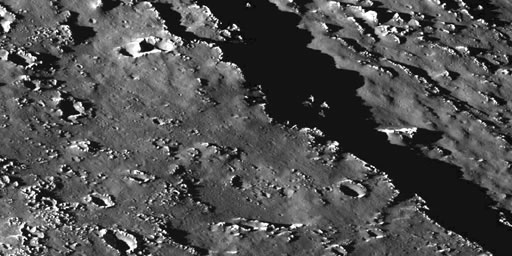
In this close-up, we can see lots of craters, and a very steep slope—or scarp—crossing the image. This scarp is just a small part of a much larger multi-ringed crater structure 4,000 kilometers (2,485 miles) in diameter.
DIGITAL EFFECT: Ganymede
Zoom in on Ganymede for better viewing.
VISUAL 27 (still) : Global Ganymede in Color (NASA Galileo mission)
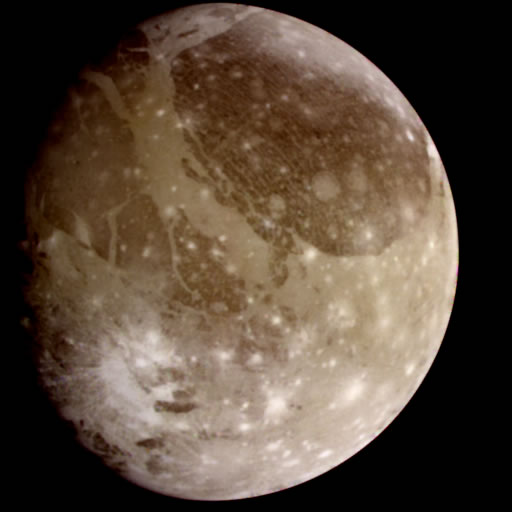
Ganymede (the “blue moon” we tracked) has frosty polar caps as well as two other types of terrains: bright, grooved terrain and older, dark furrowed areas. The two types of terrain suggest to us that Ganymede’s entire icy crust has been under tension from global tectonic processes. Ganymede is the largest moon in the Solar System—5,276 kilometers (3,280 miles) in diameter.
VISUAL 28 (still): Ganymede—Mixture of Terrains (NASA Galileo mission)
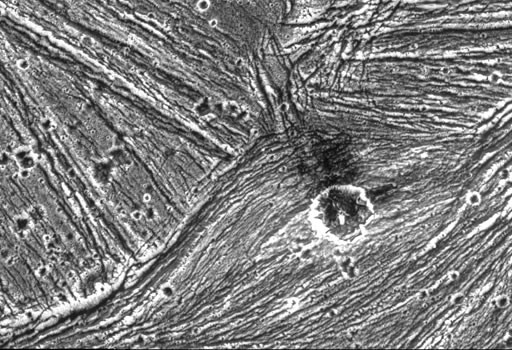
Show still image of a Ganymede surface closeup.The image shows fine details of one of the brighter areas of Ganymede, and reveals a mixture of terrain. One part is older and heavily cratered; one part is younger with line-like structures and an impact crater. Seeing terrain like this side-by-side allow scientists to work out the complex geology of Ganymede.
Optional VISUAL 29 (movie): Ganymede Geology Animation of a rotating globe of Jupiter’s moon Ganymede, with a geologic map superimposed over a global color mosaic. The 37-second animation begins as a global color mosaic (mostly shades of gray) image of the moon then quickly fades in the geologic map.
DIGITAL EFFECT: Europa
Zoom in on Europa for better viewing.
VISUAL 30 (still): Global Europa in Color (NASA Galileo mission)
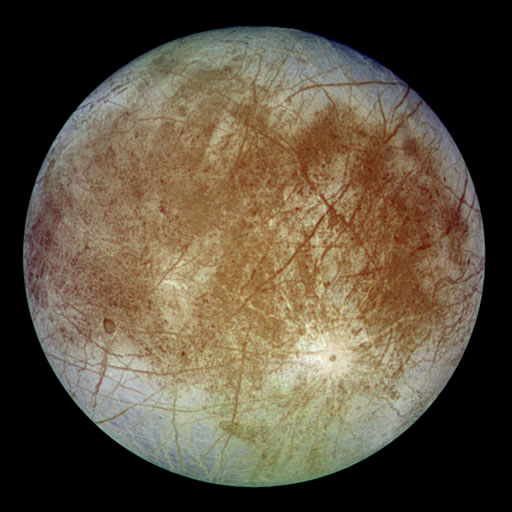
Europa (the “yellow moon” we tracked) is one of the smoothest moons in the Solar System, and only slightly smaller than Earth’s Moon. With Europa’s surface temperature of -260° F, it is completely covered in ice. The lines we see here are cracks in that ice. We expected to find quartz-hard ice like on Ganymede, but we find evidence that slush or even liquid water is beneath the moon’s surface. The warmth from a tidal tug of war with Jupiter and neighboring moons could be keeping large parts of Europa a liquid ocean.
VISUAL 31 (still): Europa—Ice Rafting View (NASA Galileo mission)
[Show still image of a Europa surface closeup.]
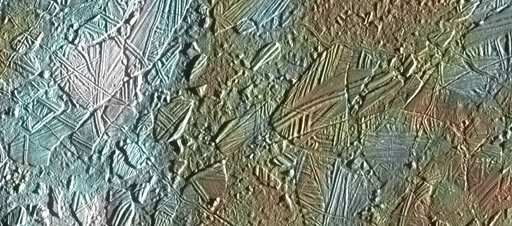
Large plates of ice seem to be sliding over a warm interior on Europa, much like Earth’s continental plates move around on our planet’s partly molten interior. Some recent images show features that have many similarities to new crust formed at mid-ocean ridges on the Earth’s sea floor.
Europa may be slushy just beneath the icy crust. There are chunky textured surfaces like icebergs, an area littered with fractured and rotated blocks of crust, and gaps where new icy crust seems to have formed between continent-sized plates of ice. Rough and swirly material between the fractured chunks may have been suspended in slush that froze at the very low surface temperatures. Studies of craters on Europa show that they are relatively young and that subsurface ice is warm enough to collapse and fill them in time periods that are short, geologically speaking.
The combination of interior heat, liquid water, and organic material falling onto Europa from comets and meteorites means that Europa has the key ingredients for life, making this moon a laboratory for the study of conditions that might have led to the formation of life in the Solar System.
Optional (movie): Europa rotating
DIGITAL EFFECT: Io
Zoom in on Io for better viewing.
VISUAL 32 (still): Global Io in Color (NASA Galileo mission)
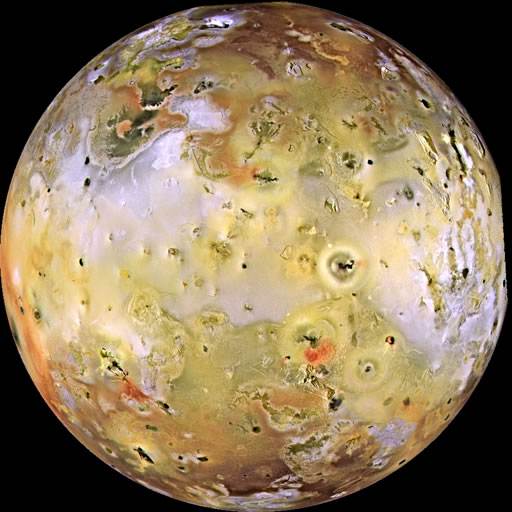
Io (the “red moon” that we tracked) is the closest Galilean moon to Jupiter and is slightly larger than Earth’s Moon. It is quite a startling contrast to other moons we have seen. Most of the craters seen here were not created by impacts, but by volcanoes!
VISUAL 33 (still) : Active Volcanic Plumes on Io (NASA Galileo mission)
[Show still image of a volcano erupting on Io.]
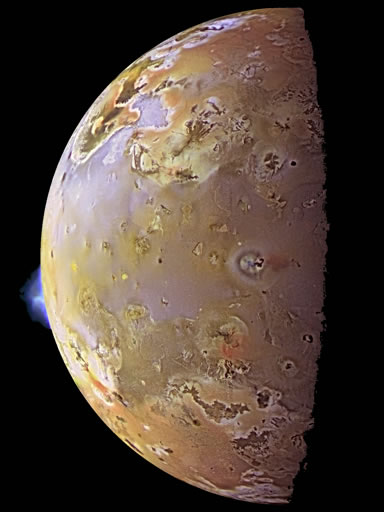
It is the most volcanically active body in the Solar System, sizzling with dozens of molten sulfur and silicate volcanoes. Most bodies in the Solar System do not have radical surface changes that are noticeable over short periods of time. But several such changes have been observed on Io between the times of the Voyager spacecraft visits to Jupiter in 1979, when no fewer than nine simultaneously erupting volcanoes were seen, and the Galileo mission of 1989-2003. The extreme volcanic activity is caused by Jupiter’s gravity generating 100 meter (330 ft) high tides in its otherwise solid surface. In this color enhanced image, deposits of sulfur dioxide frost appear in white and grey hues, while yellowish and brownish hues are probably due to other sulfurous materials.
VISUAL 34 (still): Arizona-sized Io Eruption (NASA Galileo mission)
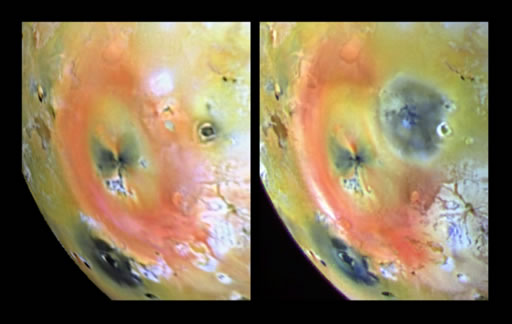
Show side-by-side comparison of before and after a volcanic eruption on Io.The image on the left shows a before picture of a region of Io. The image on the right was taken when the Galileo probe returned some time later, and a new dark spot is visible. This appears to be from a plume that rose 120 kilometers (75 miles) high and then deposited the material in an area about 400 kilometers (250 miles) in diameter—roughly the size of Arizona!
Bright red materials, such as the prominent ring surrounding the volcano named Pele, and black or dark gray spots with low brightness mark areas of recent volcanic activity and are associated with high temperatures and surface changes.
Optional VISUAL 35 (movie): Io Geology Similar to the Europa Geology movie.
Io acts as an electrical generator as it moves through Jupiter’s magnetic field, developing 400,000 volts across its diameter and generating an electric current of 3 million amperes that flows along the magnetic field to the planet’s ionosphere.
Optional VISUAL 36 (movie): Time lapse movie showing Jupiter rotating This movie is constructed from dozens of images that the Voyager spacecraft transmitted to Earth during the Voyager’s encounter with Jupiter. Jupiter actually rotates about once every 10 hours. If you watch carefully, you can see three moons whiz by.
The Galileo mission was supposed to end December 1997, but the spacecraft was in excellent shape so its duties were extended to include eight more encounters with Europa (Dec. 1997–Feb. 1999) and two more encounters with Io on Oct. 11, 1999, and Nov. 26, 1999. The extra Europa encounters were aimed at possibly confirming that an ocean presently exists on Europa, and locating some areas where the ice is thinnest. This would lead the way to possible future Europa orbiting or ice drilling missions looking into a key question for the 21st Century—is there life on Europa?
Let’s move on to the next planet out in the Solar System, the most beautiful one for many people: Saturn.
DIGITAL EFFECT: Teleport Saturn
Run through the “teleport” sequence—preparation, teleport, orbit lines, polar view (with stops)—for Saturn, as we did with Mars (above).
VISUAL 37 (still): Saturn
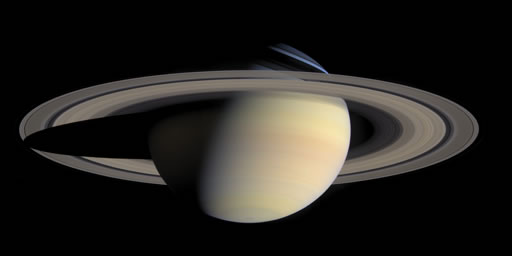
Saturn has at least 60 known moons orbiting at distances ranging from 134,000 kilometers to 13 million kilometers (84,000 miles to 8 million miles) from Saturn. The planet itself is not as colorful as Jupiter. It does have a similar banded appearance, but the zones are not as obvious, perhaps because they are partly obscured by higher layers of atmosphere.
VISUAL 38 (still): Saturn Close-up (NASA Cassini mission)
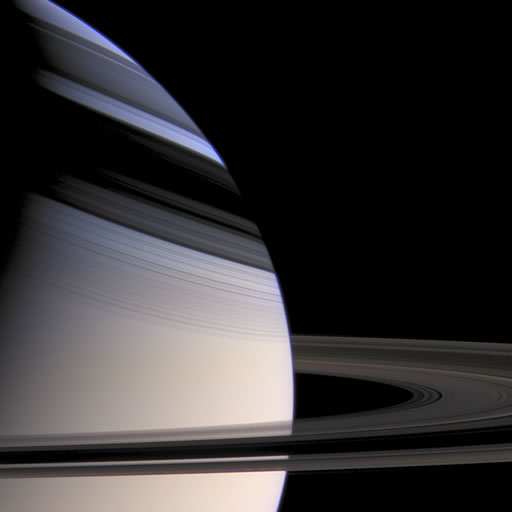
Here we see the delicate rings casting shadows on the gas giant. Saturn’s colors gradually change from gold to bluish as you move towards its north pole, but scientists don’t fully understand why. It may be a seasonal effect, resulting from the cold winter temperatures.
DIGITAL EFFECT: Mimas
Zoom in on Mimas for better viewing.
VISUAL 39 (still): Mimas (NASA Cassini mission)
[Show still image of Herschel crater.]
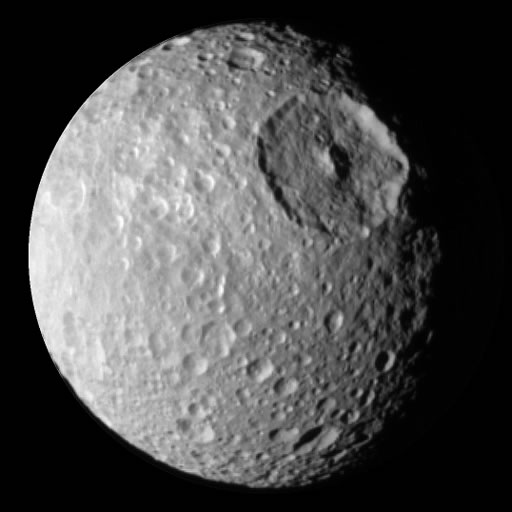
This little moon of Saturn is about 400 km (250 mi) across and is made of almost solid ice at -180°C (-300°F). A prominent impact crater can be seen here, almost 1/3 the diameter of Mimas. Images of the other side of Mimas show a large rift which could imply that the impact that caused this crater nearly cracked Mimas into two (or more) pieces.
DIGITAL EFFECT: Iapetus
Zoom in on Iapetus for better viewing.
VISUAL 40 (still): Iapetus (NASA Cassini mission)
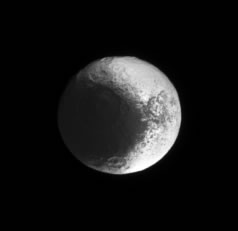
This is Iapetus, one of the outermost moons of Saturn. From your knowledge of phases, which direction is the sunlight coming from in this image?Use pointer to indicate various directions as you poll the audience.This is actually a trick question because the position of the Sun when this image was made would have been behind us. We would thus expect to see Iapetus in a full phase. This and other images made of Iapetus indicate that one side of it has really dark material on it. The dark side happens to be the leading side of Iapetus with respect to its orbital motion. That’s another puzzle for the planetary geologists, as yet unexplained.
VISUAL 41 (still): Ridge on Iapetus (NASA Cassini mission)
[Show still image of Iapetus, with a close up of the equatorial ridge.]
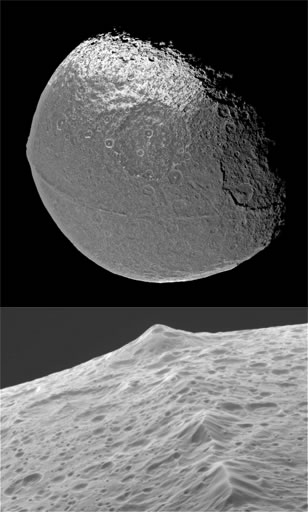
Iapetus also has a remarkable ridge that runs around almost the entire moon, closely following its equator. The peak of the ridge reaches over 10 kilometers (6 miles) in height. Where the ridge came from is still unknown. It could have formed from internal material oozing thorough a crack on the surface, or perhaps an ancient ring that once encircled Iapetus crashed onto its surface.
DIGITAL EFFECT: Titan
Zoom in on Titan for better viewing.
VISUAL 42 (still): Titan Atmosphere (NASA Cassini mission)
[Show still image of Titan with atmospheric haze.]
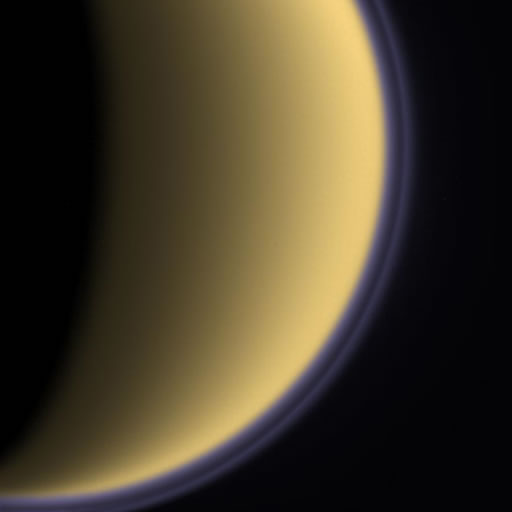
Titan is almost as large as Jupiter’s moons Ganymede and Callisto. But unlike those moons, Titan is able to retain an atmosphere. It can hold an atmosphere because it is in a colder part of the Solar System. Any gases near Ganymede or Callisto would be warm enough and energetic enough to escape the gravity of those moons. Titan’s cold atmosphere is mostly nitrogen, but is thickly laden with various hydrocarbons that some of the Voyager scientists have jokingly compared with Los Angeles smog. The atmosphere is so thick and opaque that until recently we were denied images of the surface of Titan. Measured temperatures are just about cold enough that pools of liquid ammonia, liquid methane, or liquid nitrogen could exist on the surface.
VISUAL 43 (still): Lakes on Titan (NASA Cassini mission)
[Still image of Cassini radar data, showing lakes on Titan.]
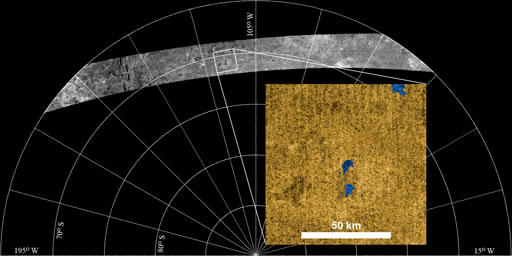
The Cassini spacecraft arrived at Saturn in June 2004 and still is operating (as of March 2011).
As part of the Cassini mission, we got our first detailed data from Titan and its surface. In January 2005, the European Space Agency’s Huygens probe drifted through the atmosphere for three hours before touching down on the surface. However, Cassini visited Titan multiple times, taking radar images of the surface. The north pole of Titan has been confirmed to have giant lakes and seas, with at least one larger than Lake Superior. These lakes seem to form from liquid methane and ethane that rains down on this extraordinary moon where the temperature is -179°C (-290°F). Images also showed rocks or ice blocks and possible methane or ethane ground fog on surface, clouds, and drainage channels.
There are still many mysteries about Saturn—how did the system of Saturn’s satellites form? How are they continuing to evolve? What is the relationship between the icy satellites and the rings of Saturn?
VISUAL 44 (still): Saturn’s Rings (NASA Cassini mission) [Bring up a still image of Saturn’s rings, as viewed from the Cassini probe.]
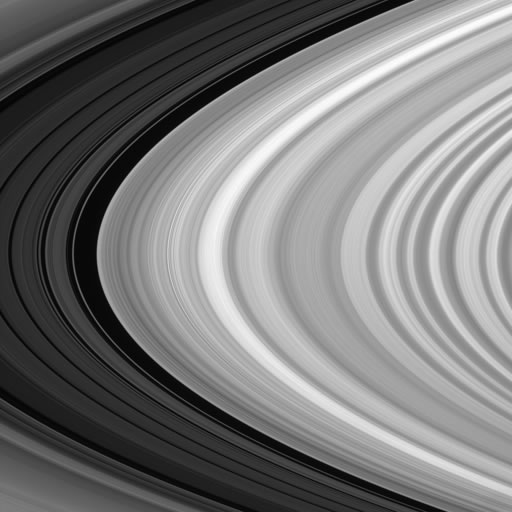
Through the best Earth telescopes, Saturn appears to have only four rings. But as our spacecraft approaches, we see they are made of dozens, indeed hundreds of narrow “ringlets.” The rings of Saturn are made of particles of ice, dust and rock. The particles range in size from a grain of sand to something larger than this planetarium. They are all orbiting Saturn as if they were each a tiny “moonlet.”
Optional
VISUAL 45 (movie): Animation of Rings
A time-lapse movie from Voyager made the same way as the one we saw from the Voyager-Jupiter encounter. The dark regions that you see moving around are referred to as “spokes” in the rings and present a great mystery because they seem to contradict laws of orbital mechanics. In the theory of orbital mechanics, particles closer to Saturn should take less time to go around in their orbits than the particles that are closer to the edge of the rings, just as we observed Io to take only 2 days to go around Jupiter while Callisto took 18 days to orbit. Since the spokes go around with the same orbital period for the inner rings as the outer ones, we have a serious dilemma. As yet, there is no theory to explain how the spokes can exist. Yet the spokes exist!
DIGITAL EFFECT (optional): Enceladus
Zoom in on Enceladus for better viewing.
Note: This moon is optional to show. However, the user may wish to add their own images of the recently discovered ice geysers on Enceladus.
Optional VISUAL 46 (movie): Shephard Moons Small moonlets have been observed orbiting just along the edges of certain rings. A theory has emerged that these moonlets, by means of their gravity, sweep ring particles inwards or outwards (depending on whether the moonlet is at the inner or outer edge of a ring) and keep the edge of the ring well defined. The moonlets have been dubbed “shepherd moons” and if it weren’t for them (if the theory is correct), there would be no well defined boundaries between ringlets as we see in our Voyager images.
Now it is time to move on to Uranus. Voyager encountered Uranus on January 26, 1986. Here is an accelerated version of what you might have seen if you had been on board. This is a computer generated simulation of the encounter.
DIGITAL EFFECT: Teleport Uranus
Run through the “teleport” sequence—preparation, teleport, orbit lines, polar view (with stops)—for Uranus, as we did with Mars (above).
VISUAL 47 (movie): Uranus Encounter (animation—NASA Voyager 2 mission)
VISUAL 48 (still): Uranus Collage (NASA Voyager 2 mission)
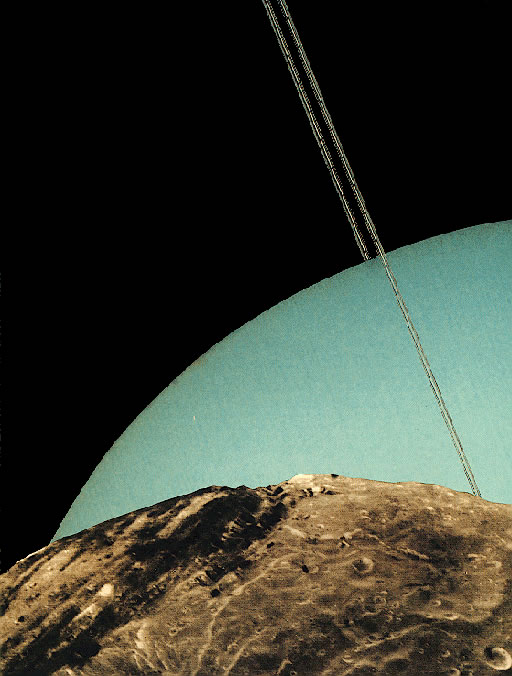
This is a collage of Uranus and its ring system as if you were standing on Uranus’ moon Miranda. Uranus has a paltry ring system compared with that of Saturn; only ten thin rings were seen. Notice the deep canyon and impact craters in the icy surface of Miranda. (Miranda and Uranus in this picture are Voyager 2 images, while the rings are artist’s conception. The apparent blue color of Uranus is its true color and is a result of the absorption of red light by methane in Uranus’ atmosphere, leaving primarily blue light to reflect back.)
Here is a great image of Miranda, which is about 480 km (300 mi) in diameter.
DIGITAL EFFECT: Miranda
Zoom in on Miranda for better viewing.
VISUAL 49 (still): Miranda Surface, Cliffs 10-15 kilometers (6-9 miles) high (NASA Voyager 2 mission)
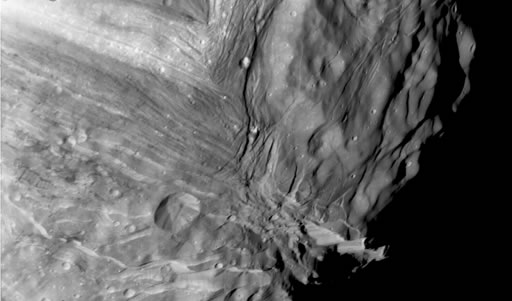
Show still image of a Miranda surface closeup. Voyager also detected 10 new moons, bringing the total number of Uranian moons to 15 at that time (as of 2003, we count 27 moons). Remember that these images were transmitted across more than a billion miles of space by a spacecraft that had already endured encounters with Jupiter and Saturn in its 9-year odyssey through the Solar System. (Voyager was launched in 1977.)
DIGITAL EFFECT: Titania
Zoom in on Titania for better viewing.
VISUAL 50 (still): Titania (NASA Voyager 2 mission)
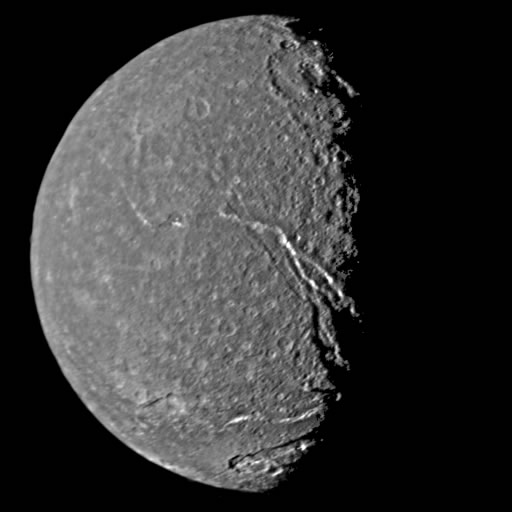
Five large moons of Uranus were known before the Voyager 2 encounter. In order of increasing size, they are Miranda, Ariel, Umbriel, Titania, and Oberon. Titania is one of the largest, about 1,600 km (1,000 mi) in diameter, roughly half the size of Earth’s Moon. Titania, for example, is marked by huge fault systems and canyons that indicate some degree of geologic activity in its history. These features may be the result of tectonic movement in its crust.
Voyager has survived its Uranus encounter in which it performed beyond our wildest dreams. It went past Neptune in an encounter in August of 1989.
DIGITAL EFFECT: Teleport Neptune
Run through the “teleport” sequence—preparation, teleport, orbit lines, polar view (with stops)—for Neptune, as we did with Mars (above).
VISUAL 51 (movie): Neptune Encounter
VISUAL 52 (still): Neptune (NASA Voyager 2 mission)
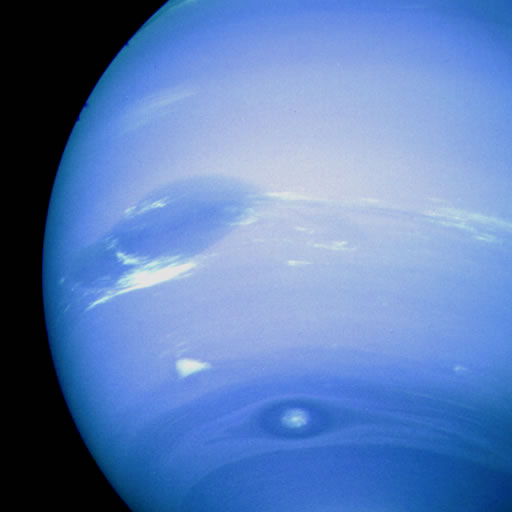
Voyager 2, a senior citizen spacecraft having spent 12 years of rigorous journey through space with three spectacularly successful encounters under its belt, performed superbly in its encounter with Neptune. It allowed us to discover 6 new Neptunian moons, bringing the total number for Neptune to 8 at that time. As of 2008, we know of 13 moons.
DIGITAL EFFECT: Triton
Zoom in on Triton for better viewing (manual zoom recommended).
VISUAL 53 (still): Triton (NASA Voyager 2 mission)
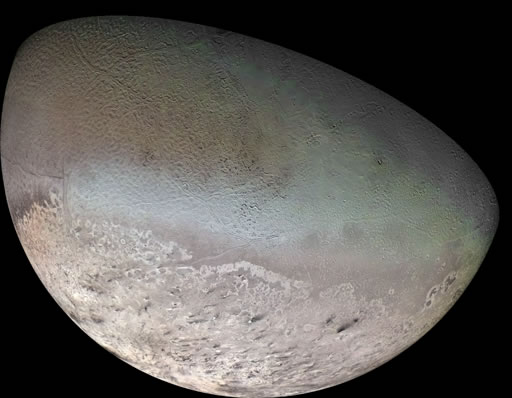
Voyager 2 sent us spectacular images of the huge moon Triton, revealing ice volcanoes. Voyager 2, its primary mission complete, is now on its way to exit the Solar System, never to return.
As exciting as the Voyager images are, we must not forget about important discoveries made by astronomers with Earth-based telescopes.
Observations obtained by NASA’s Hubble Space Telescope and ground-based instruments reveal that Triton seems to have heated up significantly since the Voyager spacecraft visited—it has been undergoing a period of global warming. The warming trend is causing part of Triton’s frozen nitrogen surface to turn into gas, thus making its thin atmosphere denser. Even with the warming, no one is likely to plan a summer vacation on Triton, even though its temperature has risen about three degrees to a whopping -234°C (-389°F). If Earth experienced a similar change in global temperature over a comparable period, it could lead to significant climatic changes.
By studying the changes on Triton, the scientists hope to gain new insight into Earth’s more complicated environment.
VISUAL 54 (still): Pluto
[Bring up a still image of Pluto and its three satellites, as imaged by Hubble.]
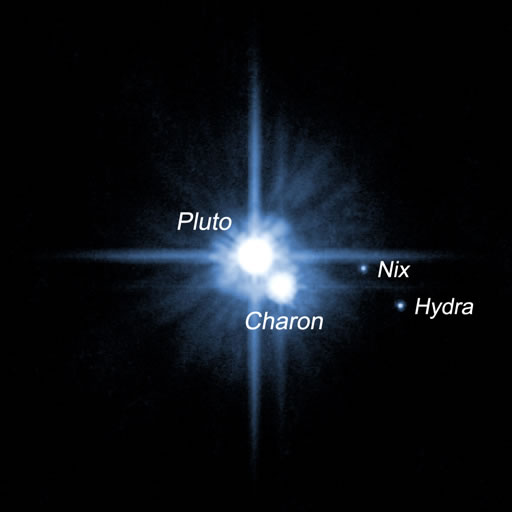
Pluto, dwarf planet beyond Neptune, was found to have a large satellite companion in 1978 with the aid of an Earth-based telescope. This satellite was given the name Charon (pronounced “Shar’-on,” after the wife of the discoverer, Charlene). In Greek & mythology, this is the boatman that carries souls across the river Styx to the underworld, in which the god Pluto reigned. In 2005, astronomers discovered two more companions to Pluto, and named them Nix (goddess of the night and mother of Charon) and Hydra (a nine-headed serpent, who kept its den at the entrance of Hades, where Pluto lived). These tiny companions were discovered with the Hubble Space Telescope.
Most inner moons in the solar system keep one face pointed toward their central planet, just like our own Moon always points the same face towards Earth. This animation shows that certainly isn’t the case with the small moons of Pluto, which behave like spinning tops. Pluto is shown at center with, in order, from smaller to wider orbit: Charon, Styx, Nix, Kerberos, Hydra. Kerberos rotates once every 5.33 Earth days, the slowest rotation rate, while Hydra, the fastest, makes an unheard of 89 rotations per orbit of the dwarf planet.
Optional
VISUAL 55 (still): Ida and Dactyl
[Show image of Ida and Dactyl, asteroid with moon.]
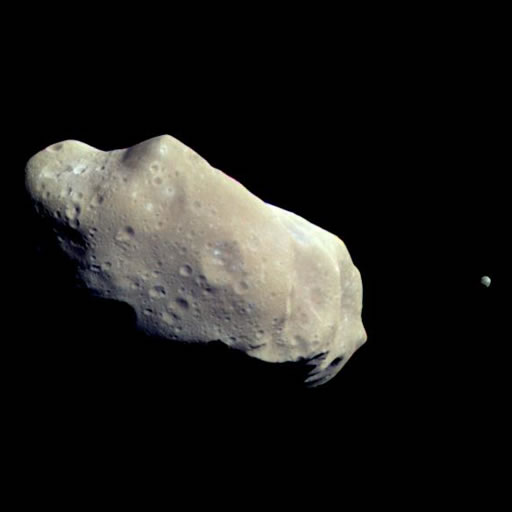
August 28, 1993 Galileo spacecraft, on its way to Jupiter, came within 2,400 km (1,500 mi) of Ida, the second asteroid ever encountered by a spacecraft. Ida is about 56 x 24 x 21 km (35 x 15 x 13 mi) in size, Dactyl is the first natural satellite of an asteroid ever confirmed and photographed. It is about 1.2 by 1.4 by 1.6 km (0.75 by 0.87 by 1 mi) across.
DIGITAL EFFECT: Return to Earth
End the tour. Fade off the entire sky to “instantly” transport us back to Earth orbit. Orbit Earth slowly before landing.
DIGITAL EFFECT: Land
“Land” on Earth by first approaching it, and then fading the scene off. Land back on Earth at your local latitude and longitude on today’s date at noon, and then fade on the scene

